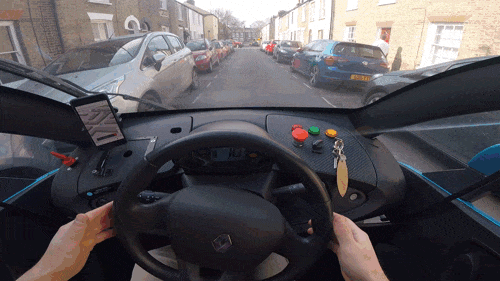April 9, 2019 weblog
Machine learning drives self-driving approach from Wayve

For the self-driving car skittish, what could be more of a nail-biter than imagining your autonomous car making its way down narrow city streets in the UK, parking permitted on both sides of the space-choked narrow path, on a wet, cloudy day, cyclists, small delivery vans on your path, at intersections, everywhere, the works.
Well, Cambridge, UK-based Wayve through this video "Urban Driving with End-to-End Deep Learning" lets you know this can be done nicely and their system has it all down pat.
Wayve is in the business of self-driving software stack based on machine learning. No detailed maps.
What is so special about this video is that you are watching a self-driving car make its way down the urban streets it has never seen before and without an HD map of its environment. Jon Fingas in Engadget: "...It had never seen the roads before, and was only running on 20 hours of training data—it didn't even know to drive on the left side of the road or to slow down at intersections where it didn't have the right of way."
"Intelligent behaviour cannot be hand-coded, but can be learned through experience," said the company blog. "We've built a system which can drive like a human, using only cameras and a sat-nav. This is only possible with end-to-end machine learning."
They said their autonomy platform is built on the Jaguar I-PACE fully-electric SUV.
With each safety-driver intervention, they said their system learns and will improve. They said that while it will take them longer to reach their first deployment, they are riding "a fundamentally different curve."
"After a decade of working on self-driving cars, other teams still address new technical challenges with more maps, more rules and more sensors. This is unsafe, expensive and cannot scale."
We don't tell the car how to drive with hand-coded rules: everything is learned from data," Alex Kendall, CTO, said in TechCrunch, and the approach allows navigating complex, narrow urban European streets for the first time. "End-to-end deep learning," said Kendall.
Why their solution matters: "It's one step closer to autonomous rides that can navigate unfamiliar roads and unexpected situations with relative ease," Fingas said.
Mike Butcher in TechCrunch quoted Kendall. "Every time a safety driver intervenes and takes over, the car learns to drive better. We don't tell the car how to drive, rather it learns to drive from experience, example and feedback, just like a human."
The company talks up the cost advantage, too. Self-driving cars that depend on extensive computing power can be expensive and heavy.
Kendall said in TechCrunch that their solution "uses compute/sensors which cost less than 10 percent of competitors. In fact, everything operates on the equivalent of a modern laptop computer. This massively reduces our sensor and compute cost (and power requirements) to less than 10 percent of traditional approaches."
What's next? They said they will continue to see a fleet of Jaguar I-PACE vehicles testing algorithms and collecting data throughout the UK and mainland Europe.
They are to deploy autonomous vehicles in 100 cities.
One interesting comment in TechCrunch said, "I just would like to express my concern that it is relatively easy to train the network to function correctly in 90% of the time but the edge cases is where accidents happen and people get hurt."
Peter Holley's take in The Washington Post: "Using machine learning—a system in which algorithms are not hand-coded, but trained over time—the company claims its vehicles learn the same way human drivers do: through experience, mistakes, feedback and imitation. In effect, the company says, the car isn't so much being taught how to drive, but being instructed how not to drive."
More information: wayve.ai/blog/driving-like-human
© 2019 Science X Network
















